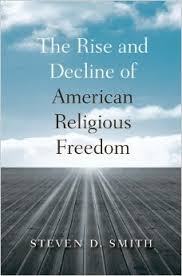 Steven D. Smith, The Rise and Decline of American Religious Freedom (Cambridge, MA: Harvard University Press, 2014). Hardback / Kindle
Steven D. Smith, The Rise and Decline of American Religious Freedom (Cambridge, MA: Harvard University Press, 2014). Hardback / Kindle
In America, religious freedom is often named “the first freedom.” One reason reason for this name is religious freedom’s pride of place in the First Amendment. Only after stating, “Congress shall make no law respecting an establishment of religion, or prohibiting the free exercise thereof,” does that amendment go on to prohibit congressional laws “abridging the freedom of speech, or of the press; or the right of the people peaceably to assemble, and to petition the Government for a redress of grievances.” The order of the First Amendment points to a second, more important reason for the name, however: the primacy of conscience that religious freedom protects.
One would think that religious freedom would unite Americans of all persuasions, religious and political. Unfortunately, however, religious freedom itself has become a controversial topic within our increasingly secular and egalitarian political culture. Flashpoints are numerous, but certain clashes are especially prominent at the present moment: the rights of religious groups at public schools, the constitutionality of the so-called ministerial exception, the burden ObamaCare’s sterilization-contraception-abortifacient mandate places on religious business owners; and the increasingly tense battle between gay rights groups and religious believers on the topic of same-sex marriage.
Underlying these conflicts are two very different narratives regarding the meaning of American religious freedom, whose differences Steven D. Smith outlines in The Rise and Decline of American Religious Freedom.
The “standard story” traces the intellectual roots of religious freedom to the Enlightenment; interprets the First Amendment as a radical innovation in public affairs; contends that its meaning was imperfectly realized in the 19th century, when evangelical Protestant Christianity was America’s established religion de facto, though not de jure; and lauds Supreme Court decisions from the mid-20th century onward for their deconstruction of this de facto establishment and construction, in its place, of secularism and neutrality toward religion. A fifth element of this narrative, increasingly evident among legal elites, though not necessarily in the courts, is the belief that religious freedom is outmoded and therefore should be discarded because it is antithetical to the egalitarian outcomes government exists to secure. If, for example, religious freedom is simply the last refuge of homophobic bigots—as same-sex marriage proponents loudly complain—why should it be preserved?
In sharp contrast to the standard story, Smith proposes a “revised version,” a point-by-point refutation of the former, or at least a counter-narrative to it. This version traces the intellectual roots of religious freedom farther back than the Enlightenment—indeed, to predominantly Christian emphases on the freedom of the church and the liberty of conscience. Far from being a radical innovation, the First Amendment was a non-controversial, ho-hum affirmation of the American status quo, affirming jurisdictional limitations on the federal government’s involvement with religion, which left state governments free to establish or disestablish religions as they pleased. The resulting “American settlement” allowed for “open contestation” between advocates of “providentialism” and “secularism,” even as it enforced jurisdictional boundaries between the federal government and the nation’s churches. Among other things, this settlement allowed presidents to declare national days of prayer and thanksgiving, politicians to offer theological motives for laws with secular effects, and public schoolchildren to pray and hear the Bible read by the teacher in the classroom. Rather than maintain this settlement, the mid-20th-century Supreme Court ended the policy of open contestation and declared that government must be both secular and neutral with regard to religion. This secular neutrality is out of step with American legal and political traditions and is not neutral with regard to religion. Rather, it deprivileges religion in favor of secular accounts of reality. As noted above, some legal theorists want to dispense with religious freedom altogether, arguing that religious believers’ rights of speech, press, freedom of association, and redress of grievances would be more than adequately protected in its absence.
But Smith wonders whether this would actually be so, closing his book with these words:
In childlike fashion, perhaps, let us indulge the assumption that unlike so many rulers throughout history, our contemporary governors are true men (and women) and good, genuinely motivated by a desire to govern justly. Even so, we might recall Justice Louis Brandeis’s observation that “[e]xperience should teach us to be most on guard to protect liberty when the Government’s purposes are beneficent… The greatest dangers to liberty lurk in insidious encroachment by men of zeal, well-meaning but without understanding.”
So it is just possible that the forgetting or forgoing of the logic of jurisdiction that animated the commitment to freedom of church and conscience, and thereby set and underscored bounds to the jurisdiction of the state, might turn out to be a loss sorely lamented…
In other words, should the first freedom fall, can the second, third, and fourth freedoms continue to withstand the encroachment of state power? That’s a good question, and Steven D. Smith should be thanked for raising it in his timely and illuminating study of American religious freedom’s rise and decline.
P.S. If you found my book review helpful, please vote “Yes” on my Amazon.com review page.

